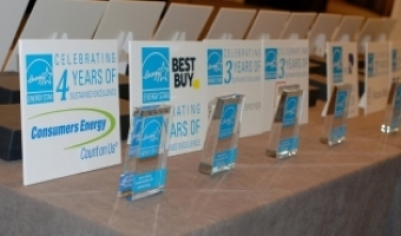

The CEE Board voted to update the CEE Residential Lighting Initiative, effective January 2, 2017, to align the strategy with a changing market. CEE News interviewed Eileen Eaton, staff co-chair of the CEE Lighting Committee, to find out what members are considering for Residential Lighting.
As part of the Energy Independence and Security Act of 2007, Congress required US DOE to complete a revised minimum efficiency standard for general service lamps no later than January 1, 2017, to take effect in 2020. Congress also added a backstop provision. If DOE fails to set a new standard that saves at least as much as a 45 lumens per watt standard, then the minimum standard for all light bulbs in 2020 becomes 45 lumens per watt.
This backstop, paired with rapid improvements in technology and increasing savings goals, has members looking to maximize the savings they can claim from lighting in the next three years. Fortunately CEE members pulled together a ready made platform to promote the highest efficacy and performing lamps in the market through the integral lamp specification.
The largest market opportunity by far, and cheapest to access, is still the installed base of inefficient bulbs. According to US EPA, there are over four billion sockets with inefficient lighting sources remaining. As these lamps are replaced, members insure that efficient bulbs are available at retail, and they encourage consumers to purchase products that maximize their energy savings and lighting experience through incentives and promotional efforts.
Members have been working to revise the ENERGY STAR® and CEE lamp specifications over the last two years in order to identify and promote the top performing lamps in the market through 2019. The new efficacy requirements increase the level of savings from each individual light bulb. In addition, both ENERGY STAR and CEE specifications address product quality to ensure that the lamps purchased meet consumer expectations, remain installed, and encourage additional efficient lighting purchases in the future. Several programs are looking to provide additional incentives to support the highest efficacy and quality lamps that meet CEE Tier 2 and advanced tier requirements.
Integral replacement lamps qualifying for the CEE Specificaiton must first meet the current ENERGY STAR® Lamp Criteria, Version 2.0, effective January 2, 2017. The Criteria includes attributes such as CRI, lifetime, dimming, and omnidirectionality that make sure the lamps appeal to customers and prevent any negative experiences for those purchasing high efficiency lamps for the first time. CEE worked with ENERGY STAR to also require that the power factor of lamps described in the criteria benefits utilities.
Good question! CEE members were concerned with the quality of lower priced lamps that don't have the ENERGY STAR designation entering the market in 2015. Many members were interested in including lower priced LED lamps in their programs and sought a pathway to identify quality products through the ENERGY STAR certification process. While it raised concerns for other members, EPA opted to lower ENERGY STAR performance requirements for lifetime and omnidirectionality to enable qualification for many lower priced bulbs.
Given the differing opinions across the Committee, the CEE tiered specification provided an elegant solution. Because the Initiative defines several tiers, CEE members have the flexibility of working with Tier 1, which meets the revised ENERGY STAR requirements, as well as a Tier 2 that maintains the more stringent ENERGY STAR criteria. This flexibility, a hallmark of CEE initiatives, allows members with different needs to harmonize their market transformation efforts.
About CEE
CEE is an award-winning consortium of efficiency program administrators from the United States and Canada. Members work to unify program approaches across jurisdictions to increase the success of efficiency in markets. By joining forces at CEE, individual electric and gas efficiency programs are able to partner not only with each other, but also with other industries, trade associations, and government agencies. Working together, administrators leverage the effect of their ratepayer funding, exchange information on successful practices and, by doing so, achieve greater energy efficiency for the public good.